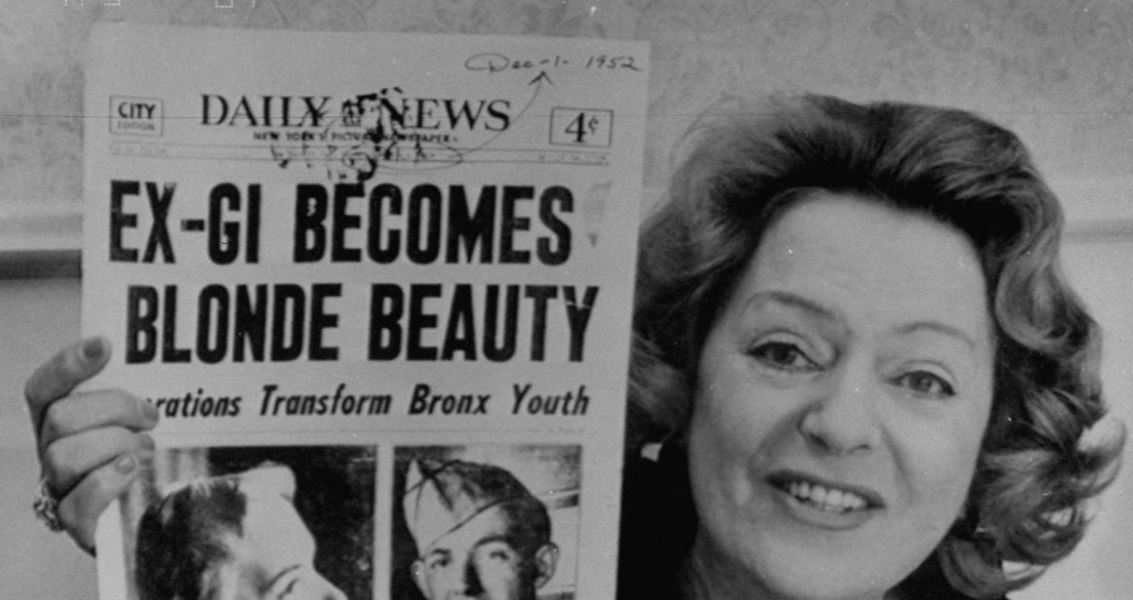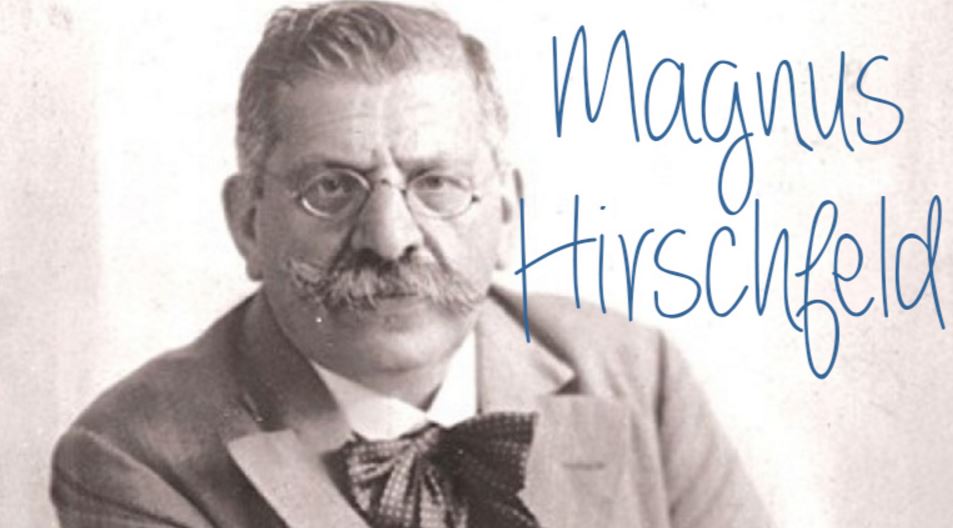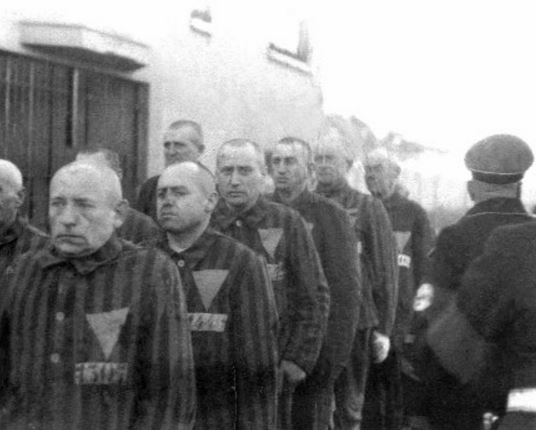It looks like you're using an Ad Blocker.
Please white-list or disable AboveTopSecret.com in your ad-blocking tool.
Thank you.
Some features of ATS will be disabled while you continue to use an ad-blocker.
12
share:
I stumbled across this interesting and highly topical article this morning, and I felt it relevant to the ongoing discussion about transgender issues.
Today, if a person suffers gender dysphoria, there are avenues by which one can consult with doctors, and if necessary, gender reassignment surgery is an option. Go back 65 years, and there were options, but they were very limited.
Christine Jorgensen is commonly considered the first person to receive gender reassignment surger back in 1953, but she was not the first person to receive this surgery.

Of interest, after WW1, Germany had a LGBT community who were not hidden from the mainstream of society. A German physician and sexologist, Magnus Hirschfeld, is credited with advocating for homosexual and transgender rights.


With the coming to power of Hitler and the Nazis, the mood of the nation changed.
en.wikipedia.org...

Hirschfeld’s Institute was raided, and his journals and research were destroyed
Many of Hirschfeld’s patients were saved due to this destruction of the documents outlining their procedures which contained identifying data.
In the years following WW2, there was not a lot of success in the US with gender reassignment surgery.
www.mercatornet.com...
One can’t help but wonder how our understanding of this issue might be different if not for the Nazis and their destruction of valuable medical research? Certainly research in the US suffered, and if the pioneering case studies of Hirschfeld existed and were accessible , many of these failures might have been avoided.
Today, if a person suffers gender dysphoria, there are avenues by which one can consult with doctors, and if necessary, gender reassignment surgery is an option. Go back 65 years, and there were options, but they were very limited.
Christine Jorgensen is commonly considered the first person to receive gender reassignment surger back in 1953, but she was not the first person to receive this surgery.

Sex reassignment surgery had an earlier life, in an unexpected time and place: 1920s Germany. Several doctors there performed such surgeries using analog technology and organic hormones. They worked under a new paradigm: What if they could make someone’s body fit their mind instead of forcing their mind to fit their body?
Of interest, after WW1, Germany had a LGBT community who were not hidden from the mainstream of society. A German physician and sexologist, Magnus Hirschfeld, is credited with advocating for homosexual and transgender rights.

Hirschfeld saw himself as an activist, constantly referring to a motto of “justice through science.”—which also made him a target of Germany’s rising far right. In 1921, he was jumped after a lecture and left for dead on the street.
He persisted, though, and became an intermediary between the German government and the trans community. One story tells of a trans woman who was arrested on counts of female impersonation. The judge contacted Hirschfeld, who consulted with the woman. She requested and received reassignment surgery, and later worked in Hirschfeld’s Institute for Sexual Science.
Two of Hirschfeld’s colleagues performed numerous reassignments and began to realize that their patients tended to be wealthy Germans. They publicized their surgeries in newspapers, hoping poorer trans people could learn about the procedures and get in touch.
By the early 1930s, people came from around the world to undergo reassignment surgery in Berlin.

With the coming to power of Hitler and the Nazis, the mood of the nation changed.
en.wikipedia.org...
Upon the rise of Adolf Hitler and the National Socialist German Workers Party (the Nazi Party) in Germany, gay men and, to a lesser extent, lesbians, were two of the numerous groups targeted by the Nazis and were ultimately among Holocaust victims. Beginning in 1933, gay organizations were banned, scholarly books about homosexuality, and sexuality in general, (such as those from the Institut für Sexualwissenschaft, run by Jewish gay rights campaigner Magnus Hirschfeld) were burned, and homosexuals within the Nazi Party itself were murdered. The Gestapo compiled lists of homosexuals, who were compelled to sexually conform to the "German norm."
Between 1933 and 1945, an estimated 100,000 men were arrested as homosexuals, of whom some 50,000 were officially sentenced.[1] Most of these men served time in regular prisons, and an estimated 5,000 to 15,000 of those sentenced were incarcerated in Nazi concentration camps.

Hirschfeld’s Institute was raided, and his journals and research were destroyed
Hitler also publicly raged against the “vice” of homosexuality and the “degenerate” lives of transsexuals. They weakened the Aryan cause.
Many of Hirschfeld’s patients were saved due to this destruction of the documents outlining their procedures which contained identifying data.
In the years following WW2, there was not a lot of success in the US with gender reassignment surgery.
www.mercatornet.com...
The setting for the first transgender surgeries (mostly male-to-female) was in university-based clinics, starting in the 1950s and progressing through the 1960s and the 1970s. When the researchers tallied the results and found no objective proof that it was successful—and, in fact, evidence that it was harmful—the universities stopped offering sex-reassignment surgery.
Since then, private surgeons have stepped in to take their place. Without any scrutiny or accountability for their results, their practices have grown, leaving shame, regret, and suicide in their wake.
One can’t help but wonder how our understanding of this issue might be different if not for the Nazis and their destruction of valuable medical research? Certainly research in the US suffered, and if the pioneering case studies of Hirschfeld existed and were accessible , many of these failures might have been avoided.
edit on 11-6-2016 by cuckooold because: (no reason given)
a reply to: cuckooold
The fact that Berlin had become a cesspool of vice was one of the reasons the Nazis were able to rise to power. It is a lot like what is happening today with Trump becoming so popular because of the backlash against the liberal destruction of America. Now we have Trump because of the decadence of our 'modern' society.
The fact that Berlin had become a cesspool of vice was one of the reasons the Nazis were able to rise to power. It is a lot like what is happening today with Trump becoming so popular because of the backlash against the liberal destruction of America. Now we have Trump because of the decadence of our 'modern' society.
originally posted by: Kali74
a reply to: Metallicus
Stay in the closet or we'll go Nazi on you?
No, I am simply saying that the Left created Donald Trump not the right and now we as a nation are stuck with him. Thanks, Obama.
a reply to: Metallicus
The Left did no such thing. The right wing in its entirety, politicians, media, echo chamber... created Donald Trump.
The Left did no such thing. The right wing in its entirety, politicians, media, echo chamber... created Donald Trump.
This is very interesting, I had no idea this was going on in Germany at the time.
a reply to: Kali74
The sentiment behind the rise of Trump is a reaction to political correctness gone wild though.
I think Trump is a buffoon but I also think that the latest crop of progressives are mentally ill and dangerously delusional. Their notions are out of touch with reality, belligerence and blind adherence to dogma have replaced reason and debate. Aggressive intolerance and censure of opponents speaks of an ideology that has lost touch with its liberal foundation. Its pretense of tolerance and diversity rings hollow, the reality is it's at odds with the very values it professes to believe in.
a reply to: Kali74
The sentiment behind the rise of Trump is a reaction to political correctness gone wild though.
I think Trump is a buffoon but I also think that the latest crop of progressives are mentally ill and dangerously delusional. Their notions are out of touch with reality, belligerence and blind adherence to dogma have replaced reason and debate. Aggressive intolerance and censure of opponents speaks of an ideology that has lost touch with its liberal foundation. Its pretense of tolerance and diversity rings hollow, the reality is it's at odds with the very values it professes to believe in.
a reply to: cuckooold
Good information, mostly. The Nazis burned the Magnus Hirschfeld Institute to the ground in 1939.
Thank you for this historical perspective although I must take exception to the quote and link to mercatornet and to the comments about private surgeons leaving shame, regret and suicide in their wake. You do realize this article is from someone that did regret, is biased and does not accurately represent the statistics regarding sex reassignment surgery. The author of the article, Walt Heyer, is well known as an anti-trans propagandist and darling of religious right-wing conservative groups.
Myths About Transition Regrets
I'm sorry but I can't find my link to the source of this graphic but I do know it is several years old.

It should also be pointed out the gender clinic at Johns Hopkins was run by the infamous Dr. Paul McHugh. Please see my two posts and 11 links to more information about McHugh on the first page of this recent thread: Former Johns Hopkins Chief of Psychiatry Says Trans Movement is “Collaborating with Madness”
I actually made an application to the program at Johns Hopkins in 1974 when I was 19. I had already been diagnosed by several physicians and psychiatrists as having "primary transsexualism", what we now know as gender dysphoria, and was already working and known as a girl by that time and on HRT. More accurately, I had an application to the program but it was something like 27 pages long and one of the most ridiculous things I've ever seen in my life. My mother looked at it and her words were "you've got to be kidding?" I never completed or submitted it and the whole experience was so invasive and frustrating, it sent me into a dark depression and state of unhappiness for a considerable time. I also tried to get into the program at Stanford but don't remember why that one didn't work out either. Money probably as I was working for $2.15 an hour at the time.
Things really came together (or back together) with the science and research with the 1966 publication of The Transsexual Phenomenon by Dr. Harry Benjamin.

A good 5-part history and biography of Dr. Benjamin can be found on the pages of a website called A Gender Variance Who's Who, which is one of the most comprehensive history sites for all things trans and gender variant. Benjamin died in 1986 at the ripe old age of 101 and a more brief synopsis of his life and career can be found on wikipedia. From the work of Dr. Benjamin, the HBIGDA (Harry Benjamin International Gender Dysphoria Association) was formed that is now known as WPATH, the World Professional Association for Transgender Health. WPATH publishes the internationally accepted Standards of Care
After several difficult and challenging years, things did work out for me when I was 22 with the help of the famous "sex change" surgeon, Dr. Stanley Biber (wikipedia) in what was known for many years as the "sex change capitol of the world", Trinidad, Colorado. There's an article and video about Trinidad here but this was after Biber's practice was taken over by Marci Bowers (wikipedia) or marcibowers.com
Thank you for the opportunity to share some information and links and for your thread with some background on Hirschfeld. S & F for you!
Good information, mostly. The Nazis burned the Magnus Hirschfeld Institute to the ground in 1939.
Thank you for this historical perspective although I must take exception to the quote and link to mercatornet and to the comments about private surgeons leaving shame, regret and suicide in their wake. You do realize this article is from someone that did regret, is biased and does not accurately represent the statistics regarding sex reassignment surgery. The author of the article, Walt Heyer, is well known as an anti-trans propagandist and darling of religious right-wing conservative groups.
Surgical regret is actually very uncommon. Virtually every modern study puts it below 4 percent, and most estimate it to be between 1 and 2 percent (Cohen-Kettenis & Pfafflin 2003, Kuiper & Cohen-Kettenis 1998, Pfafflin & Junge 1998, Smith 2005, Dhejne 2014). In some other recent longitudinal studies, none of the subjects expressed regret over medically transitioning (Krege et al. 2001, De Cuypere et al. 2006).
Myths About Transition Regrets
I'm sorry but I can't find my link to the source of this graphic but I do know it is several years old.

It should also be pointed out the gender clinic at Johns Hopkins was run by the infamous Dr. Paul McHugh. Please see my two posts and 11 links to more information about McHugh on the first page of this recent thread: Former Johns Hopkins Chief of Psychiatry Says Trans Movement is “Collaborating with Madness”
I actually made an application to the program at Johns Hopkins in 1974 when I was 19. I had already been diagnosed by several physicians and psychiatrists as having "primary transsexualism", what we now know as gender dysphoria, and was already working and known as a girl by that time and on HRT. More accurately, I had an application to the program but it was something like 27 pages long and one of the most ridiculous things I've ever seen in my life. My mother looked at it and her words were "you've got to be kidding?" I never completed or submitted it and the whole experience was so invasive and frustrating, it sent me into a dark depression and state of unhappiness for a considerable time. I also tried to get into the program at Stanford but don't remember why that one didn't work out either. Money probably as I was working for $2.15 an hour at the time.
Things really came together (or back together) with the science and research with the 1966 publication of The Transsexual Phenomenon by Dr. Harry Benjamin.

A good 5-part history and biography of Dr. Benjamin can be found on the pages of a website called A Gender Variance Who's Who, which is one of the most comprehensive history sites for all things trans and gender variant. Benjamin died in 1986 at the ripe old age of 101 and a more brief synopsis of his life and career can be found on wikipedia. From the work of Dr. Benjamin, the HBIGDA (Harry Benjamin International Gender Dysphoria Association) was formed that is now known as WPATH, the World Professional Association for Transgender Health. WPATH publishes the internationally accepted Standards of Care
After several difficult and challenging years, things did work out for me when I was 22 with the help of the famous "sex change" surgeon, Dr. Stanley Biber (wikipedia) in what was known for many years as the "sex change capitol of the world", Trinidad, Colorado. There's an article and video about Trinidad here but this was after Biber's practice was taken over by Marci Bowers (wikipedia) or marcibowers.com
Thank you for the opportunity to share some information and links and for your thread with some background on Hirschfeld. S & F for you!
I came across this British documentary a few months ago that also provides a lot of historical context. Not sure when it was produced but I think it
has got to be at least 20 or so years old? It says 2000 but I think it is older? It starts out with the Nazis and Hirschfeld. It says it was 1933 when
Hirschfeld's work was burned and I said above it was 1939. I'll have to verify which is correct but don't have time at the moment.
Caution! This isprobably NSFW and some of the descriptions and terminology are cringeworthy by today's standards but it still worth
the hour to watch.
Caution! This is
new topics
-
Just spotted an unusual aircraft Melbourne Australia
Aliens and UFOs: 2 hours ago -
The truth lets admit it
Aliens and UFOs: 7 hours ago -
Mass Shooting Towson, Maryland - 7 shot, 1 possibly dead
Social Issues and Civil Unrest: 10 hours ago
top topics
-
Trump formally clinches Electoral College victory
2024 Elections: 15 hours ago, 17 flags -
Mass Shooting Towson, Maryland - 7 shot, 1 possibly dead
Social Issues and Civil Unrest: 10 hours ago, 5 flags -
The truth lets admit it
Aliens and UFOs: 7 hours ago, 4 flags -
Just spotted an unusual aircraft Melbourne Australia
Aliens and UFOs: 2 hours ago, 1 flags
active topics
-
Russias War Against Religion in Ukraine
World War Three • 29 • : andy06shake -
Is this really what is going on?
General Conspiracies • 51 • : Owlwatcher -
The truth lets admit it
Aliens and UFOs • 14 • : andy06shake -
Mass Shooting Towson, Maryland - 7 shot, 1 possibly dead
Social Issues and Civil Unrest • 10 • : TzarChasm -
Defending the need for adherence to Old Testament commandments under the new covenant of Christ
Conspiracies in Religions • 39 • : ADVISOR -
Could rampant land speculation have caused the Civil War?
History • 40 • : Solvedit -
Something better
Dissecting Disinformation • 45 • : AdultMaleHumanUK -
Elon Musk has Meeting with Nigel Farage at Mar-a-Lago
Regional Politics • 7 • : gortex -
Just spotted an unusual aircraft Melbourne Australia
Aliens and UFOs • 0 • : Cavemannick -
And Here Come the Excuses!!
General Conspiracies • 202 • : andy06shake
12
